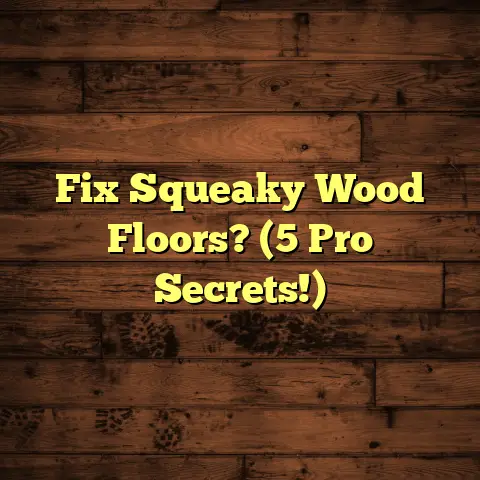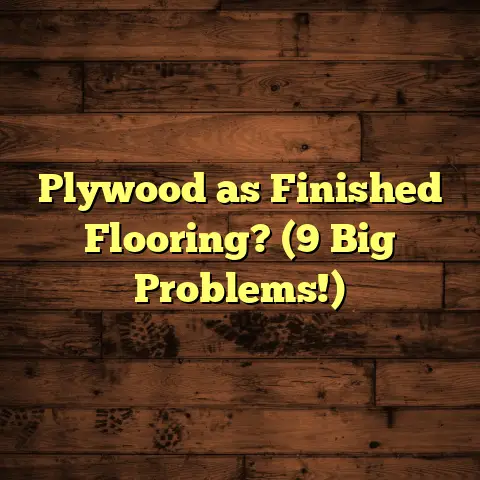Fix Squeaky Floors Under Carpet? (5 Quick Fixes!)
It’s like our houses are telling us it’s time for a little TLC before the holiday hustle begins.
And let’s be honest, nothing ruins a peaceful evening faster than a chorus of squeaky floors under that comfy carpet!
I’m here to tell you, as a flooring contractor with over 15 years in the game, those annoying squeaks don’t have to be a permanent fixture.
They’re a common issue, especially with carpeted floors, and you might be surprised at how easy it can be to silence them.
In this article, I’m going to walk you through five quick and effective fixes that’ll have your floors feeling (and sounding) like new in no time.
Let’s get to it!
Understanding the Cause of Squeaky Floors
Before we dive into the fixes, let’s talk about why floors squeak in the first place.
It’s not just old age!
The main culprit, especially under carpet, is friction.
Think of it like this: your floorboards are constantly expanding and contracting with changes in humidity and temperature.
This is particularly true during seasonal transitions.
I’ve seen it time and time again.
As the wood rubs against the subfloor, nails, or even other boards, you get that telltale squeak.
Here’s a simplified breakdown:
- Wood Movement: Expansion/contraction due to humidity.
- Friction Points: Where floorboards rub against subfloor/nails.
- Carpet Factor: Can amplify the sound and trap moisture.
The type of flooring, the age of your home, and how the floors were originally installed also play a role.
Older homes, for instance, often have floorboards that weren’t as tightly secured as they are today.
According to the National Association of Home Builders, the average lifespan of hardwood flooring is 75-100 years, but that doesn’t mean they won’t develop squeaks along the way!
I know it can feel overwhelming when you’re dealing with a noisy floor, but trust me, there are simple solutions.
Let’s get started with our first quick fix!
Quick Fix #1 – Apply Lubricant
This is one of the oldest tricks in the book, and it’s often surprisingly effective.
We’re talking about using powdered graphite or talcum powder as a lubricant.
Think of it like WD-40 for your floors, but in powder form.
The idea is to reduce the friction between the floorboards that are causing the squeak.
Here’s how to do it:
Locate the Squeaky Area: Walk around the room and pinpoint exactly where the squeak is coming from.
Mark it with tape or a pencil.Lift the Carpet: Gently lift the carpet around the squeaky area.
You might need a pair of pliers to pull up the edge from the tack strip.
Be careful not to damage the carpet!-
Apply the Lubricant: Sprinkle a generous amount of powdered graphite or talcum powder directly onto the floorboards or into the seams between them.
Work it In: Use a soft brush or even your fingers to work the lubricant into the crevices.
The goal is to get it between the surfaces that are rubbing together.Re-secure the Carpet: Carefully tuck the carpet edge back onto the tack strip.
Make sure it’s firmly in place to prevent tripping hazards.
Safety Considerations:
- Make sure the area is well-ventilated when using powdered graphite.
You don’t want to inhale too much of it. - Avoid using too much talcum powder, as it can create a mess.
A little goes a long way!
I’ve seen this fix work wonders, especially for minor squeaks.
It’s a quick, inexpensive solution that’s definitely worth trying first.
Quick Fix #2 – Use Squeak-Relief Kits
If the lubricant trick doesn’t quite do the job, it’s time to bring in the big guns: squeak-relief kits.
These kits are specifically designed to eliminate squeaks by securing the floorboards to the joists below.
They typically include screws, brackets, and a special tool to help you drive the screws in at the correct angle.
Here’s how to install one of these kits:
-
Locate the Squeaky Area: Just like before, pinpoint the exact location of the squeak.
Find the Floor Joist: This is crucial.
You need to know where the joist is located beneath the floorboards.
You can use a stud finder or, if you have access to the basement, you can look up from below.Prepare the Kit: Follow the instructions that come with your specific kit.
Usually, you’ll need to attach a bracket to the floorboard.Drive the Screws: Using the special tool provided in the kit, drive the screws through the bracket and into the floor joist.
The screws are designed to snap off at a predetermined depth, so you don’t have to worry about over-tightening them.Test the Area: Walk around the area to see if the squeak is gone.
If not, you may need to install additional screws.
Effectiveness and Damage:
- These kits are highly effective because they directly address the root cause of the squeak: loose floorboards.
- They cause minimal damage to carpets because the screws are driven in at an angle that avoids snagging the fibers.
I’ve found that squeak-relief kits are a great option for homeowners who want a more permanent solution without having to tear up their carpets.
Quick Fix #3 – Secure Loose Carpeting
Sometimes, the squeak isn’t coming from the floorboards themselves, but from the carpet rubbing against the subfloor.
Loose carpeting can definitely contribute to those annoying noises.
Here’s how to secure it:
-
Identify Loose Areas: Walk around the room and look for areas where the carpet feels loose or moves excessively when you step on it.
-
Lift the Carpet: Gently lift the carpet edge from the tack strip in the affected area.
-
Re-stretch the Carpet: Use a carpet stretcher (you can rent one from most home improvement stores) to re-stretch the carpet, ensuring it fits snugly against the floor.
-
Apply Adhesive (Optional): If the carpet is still loose after stretching, you can apply a thin layer of carpet adhesive or double-sided tape to the subfloor.
-
Re-secure the Carpet: Carefully tuck the carpet edge back onto the tack strip, making sure it’s firmly in place.
Benefits:
- This method not only fixes squeaks but also improves the overall appearance of the room by eliminating wrinkles and bulges in the carpet.
- It’s a relatively inexpensive fix that can make a big difference in the comfort and quietness of your home.
I’ve seen this fix work wonders, especially in areas with high foot traffic.
It’s a simple way to tighten up your carpet and eliminate those friction-related squeaks.
Quick Fix #4 – Install a Soundproofing Underlayment
If you’re looking for a more comprehensive solution, consider installing a soundproofing underlayment beneath your existing carpet.
This is a bit more involved than the previous fixes, but it can provide long-lasting results and significantly reduce noise transmission.
Here’s how to do it:
Choose an Underlayment: There are many different types of soundproofing underlayments available, including rubber, foam, and cork.
Choose one that’s specifically designed for use under carpet.-
Measure the Area: Measure the area where you want to install the underlayment and cut it to size using a utility knife.
-
Lift the Carpet: Carefully lift the carpet in the affected area, as well as the existing padding.
-
Clean the Subfloor: Make sure the subfloor is clean and free of debris.
-
Lay the Underlayment: Lay the soundproofing underlayment over the subfloor, making sure it’s smooth and flat.
-
Reinstall the Carpet: Reinstall the carpet over the underlayment, making sure it’s securely attached to the tack strip.
Benefits:
- Soundproofing underlayments not only reduce squeaks but also absorb impact noise, making your home quieter and more comfortable.
- They can also improve the insulation of your floors, helping to keep your home warmer in the winter and cooler in the summer.
I often recommend this option to clients who are particularly sensitive to noise or who live in multi-story homes.
It’s a great way to create a more peaceful living environment.
According to the Soundproof Cow, a leading provider of soundproofing solutions, a good quality underlayment can reduce noise transmission by as much as 50%!
Quick Fix #5 – Tighten Floorboards (If Accessible)
This fix is a bit more advanced, but it can be highly effective if you have access to the floorboards from below, such as in a basement or crawl space.
The goal is to tighten any loose boards by securing them to the joists.
Here’s how to do it:
Locate the Squeaky Area: Have someone walk around the room above while you’re in the basement or crawl space.
This will help you pinpoint the exact location of the squeak.-
Identify Loose Boards: Look for floorboards that are visibly loose or that move when someone steps on them above.
Secure the Boards: Use screws or nails to secure the loose boards to the joists.
Make sure the screws or nails are long enough to penetrate the joists securely.Work Carefully: Be careful not to damage the carpet above.
Use a stud finder to avoid driving screws or nails through the carpet.Test the Area: Have someone walk around the room above to see if the squeak is gone.
If not, you may need to add additional screws or nails.
Tools Needed:
- Drill
- Screws or nails
- Stud finder
- Safety glasses
Safety First:
- Always wear safety glasses when working with power tools.
- Be careful not to damage any electrical wiring or plumbing pipes.
I’ve found that this fix is most effective for older homes where the floorboards have become loose over time.
It’s a more permanent solution that addresses the root cause of the squeak.
Conclusion
So there you have it: five quick fixes for squeaky floors under carpet!
Addressing those annoying squeaks is a key part of creating a comfortable and inviting living space, especially as we head into the cozy seasons.
Let’s recap what we’ve covered:
- Apply Lubricant: A simple and inexpensive way to reduce friction.
- Use Squeak-Relief Kits: A more permanent solution for securing loose floorboards.
- Secure Loose Carpeting: Tighten up your carpet to eliminate friction-related squeaks.
- Install a Soundproofing Underlayment: A comprehensive solution for reducing noise transmission.
- Tighten Floorboards (If Accessible): Secure loose boards from below for a more permanent fix.
I encourage you to take action and try one (or more) of these fixes.
You’ll be amazed at how much quieter and more peaceful your home can be!
Remember, a little bit of effort can go a long way in creating a home that you truly love.
Now go forth and silence those squeaks!





